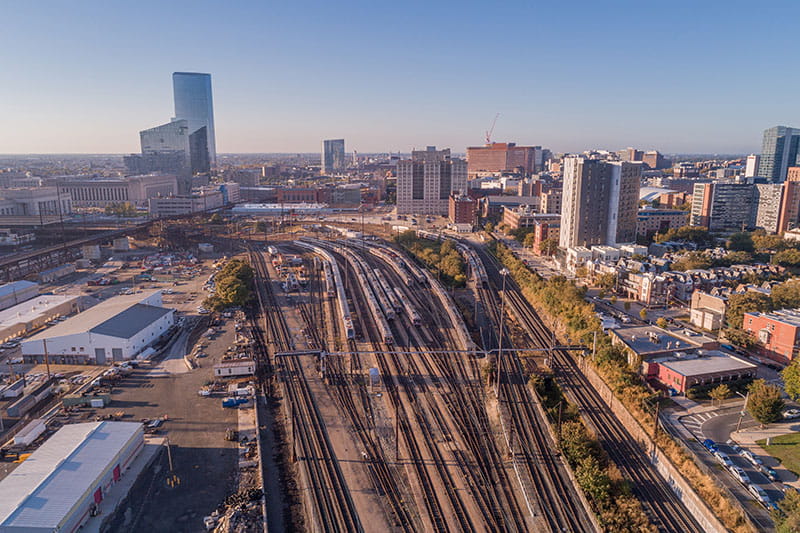7 Dream Projects to Improve Philly Under the New Infrastructure Bill

- Ribbon-Cutting Ceremony Marks Official Unveiling of Drexel Station at 30th Street
- Express Your Thoughts About Climate Change in the Anthems for the Anthropocene Contest
- 40 Years Ago, Drexel Made Computer — and Apple — History
- Drexel Helps Promote Philadelphia as a Premier Destination for Global Education

The following essay was originally published in The Philadelphia Inquirer in collaboration with Drexel University’s Lindy Institute for Urban Innovation as part of Rebuilding Philly, a series of commentary articles written by Drexel faculty and professional staff related to the COVID-19 pandemic and racial and economic equity gaps in Philadelphia. It was written by Harris M. Steinberg, executive director of the Lindy Institute for Urban Innovation at Drexel University.
With the passage of President Joe Biden’s landmark $1 trillion infrastructure bill, it is time to ask how we want to use the funds.
The bill includes funding to rebuild America’s crumbling infrastructure while investing in new technologies and programs to make the country more competitive, healthier, and equitable. The bill covers traditional infrastructure such as roads, bridges, airports, seaports, water, and rail systems while also greatly expanding broadband service across the country. It includes funding for large, complex transformational projects.
Importantly, it contains funding to reconnect the largely Black and brown communities that were severed by highways and other infrastructure in the past. There is funding for public transportation and electric vehicles, and it will invest in rebuilding the nation’s power grid. There is also significant funding to clean up toxic sites across the country.
So, what does this mean for Philadelphia and are we ready to receive the torrent of anticipated funding? This is a once in a lifetime investment in communities across the country.
Here’s my wish list:
Sink I-95
Erase the sins of I-95 along the central Delaware riverfront as the highway in this area is reaching its 50-year built-in obsolescence. Plans are underway to rebuild it largely in kind. Seize the moment to put this eyesore underground and create acres of parks and development sites as the city can finally return to its riverine roots. Bury the mass of SEPTA tracks blocking the end of Market Street and create an on-grade promenade from Front Street to the Delaware River.
Connect the former PES refinery with Point Breeze
Create a public-private partnership to position the 1,400-acre former oil refinery on the Lower Schuylkill for the future. Imagine turning I-76 at Point Breeze into a boulevard and creating a walkable connection to the river. Invest in robust green infrastructure to counter the impacts of climate change and create generous public spaces throughout this parcel that is larger than all of Center City.
The Northeast Corridor
Remediate the acres upon acres of abandoned factories in North Philadelphia along the Amtrak line to New York. Imagine new development, including 21st century manufacturing, along this rich transit spine. Adapt and reuse as many of these magnificent structures as possible.
Rethinking SEPTA
This is our chance to create a truly modern 21st century transit system. Think of high-speed transit to King of Prussia hugging the Schuylkill Expressway. Think transit stops on West Market Street and the Navy Yard. Build the Roosevelt Boulevard line and connect the former oil refinery on the Lower Schuylkill with Center City and the airport.
Development at 30th Street Station
Sink the SEPTA rail lines at 30th Street and create a grade-level crossing from University City to the 88-acres of new development sites in the rail yards. Redesign the Gordian Knot of highway as I-76 connects to I-676 as it crosses the Schuylkill. With high-speed rail along the Northeast Corridor, development at 30th Street resets the center of gravity for Philadelphia as it has become a key hub along the New York and Washington corridor.
The Lehigh Viaduct
Create a sweeping, democratic green space from deep in the heart of postindustrial North Philadelphia to the Delaware River at the Port Richmond rail yards. This Industrial Age transit corridor is 12-rail tracks-wide at the river. Add vital green space to the Black and brown neighborhoods surrounding this transit relic and connect those communities to the larger Fairmount Park system.
Rails to trails
Activate the 77 miles of abandoned or underutilized rail beds across Philadelphia. Repurpose them as a green armature for the more than 200,000 Philadelphians who do not have access to park space.
These are but a few of the many ideas that would be transformational for Philadelphia. We won’t get this opportunity again. In the past, it’s always been a zero-sum game as we’ve fought for our share of a shrinking pot of funds. This time the money is there for the asking. But we need a plan, and the clock is ticking.
It’s our moment to dream big, Philadelphia. Are we ready?
In This Article
Drexel News is produced by
University Marketing and Communications.